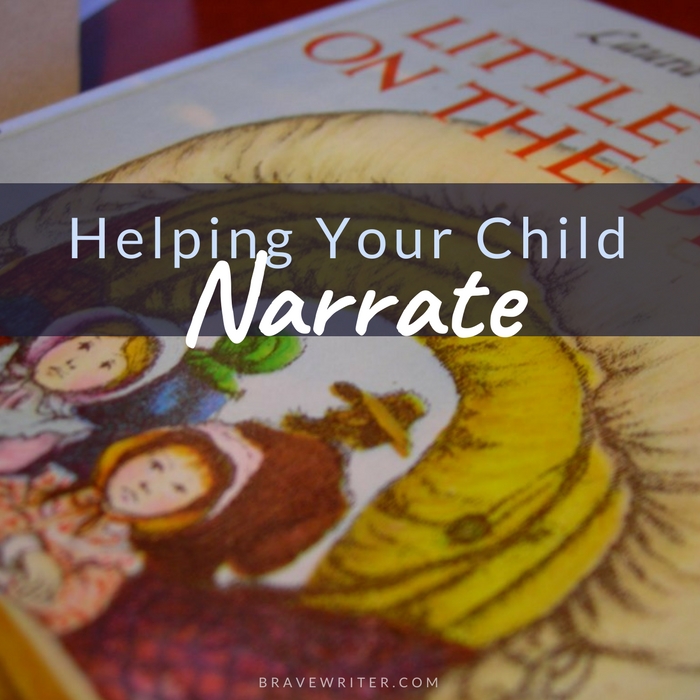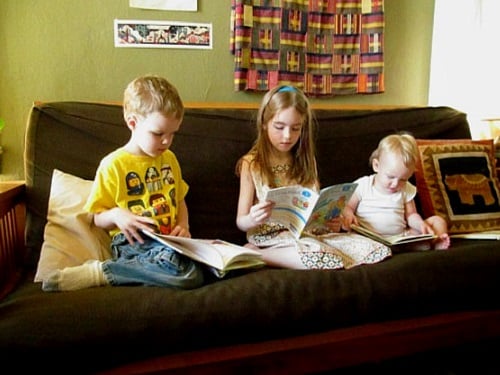Retelling: Details or Summary or Both?

Great phone call today. Here’s the gist:
Mom: What do I do when my son [age 11] retells the details of a book or movie or story, but he can’t tell me the overarching narrative that goes with it? Like he can’t say the main plot points. He rambles and gets caught up in details that are non-essential to the plot, but he tells them with so much accuracy and depth, I hate to stop him.
My response:
Adults summarize. They can pick out the main points and sequence them. They’ve read 1000s of stories, watched as many films, and are well aware of the narrative arc (plot diagram) by virtue of time on the planet and years logged reading/absorbing “story.”
Kids don’t have this background, and can’t summarize like you. They’re younger. Story is fresh for them. They are beguiled by subplots and character quirks and twists. They chase the shiny object called “weapons,” “cute puppies,” “sassy friends,” “weird creatures,” “magic spells” or “epic battles” and report all that is filling their imaginations to the brink of enthusiasm. When you ask them to tell you about the story, the most exciting, fascinating points overflow. They can’t “sort” the images and emotions. They aren’t likely to sequence events into the narrative arc. They retell the memorable moments, with detail, reliving them in front of you.
Of course, most adults have completely lost the ability to trap details to that extent. Our brains are too busy for detail. We save the important markers and ditch the quirky dialog or style of weaponry. Children can retell with amazing accuracy. We have too many digits, words, experiences, memories, obligations in the way of uncluttered retelling. We hang onto the big picture and file it under “mental notecard” – as in, if asked, this is what I share.
Being able to summarize is a fairly sophisticated skill. It is possible to cultivate, but please don’t think it a superior skill to retelling in detail. For now, here’s how I want you to proceed:
Start by listening, really closely. Ask real questions that help you understand who, what, where, and when as the child relates the particular scene. You can jot down the responses on separate sheets of paper per scene or image or dialog. Keep these on a table in front of you. Ask for key details (names, places, why such-and-such happened).
Print a plot diagram (a simple one).
Then, with these notes in front of you both, ask some of these questions to help sort the information just shared:
1. Pick up one of the stories: Did this event happen at the beginning, or in the middle, or near the end of the story/film/book? Move the note you took to the right place on the table along the narrative arc. Do that for each of the scenes you’ve jotted down.
2. Ask the child what moment decided the outcome (the climax)? It may be difficult to identify the single one (there are lots of sub-plots in most stories). But the BIG one happens near the end. So direct your child’s attention to the end of the plot line. You can even discuss ones that were important along the way, but weren’t the final key determining factor. That’s a good conversation to have!
3. Talk about the characters. Which character is the most important to the story (without whom, there would be no story)? It’s usually obvious, but not always! The main character is called “the protagonist” and that is the one who is a part of the climax. We figure out who is important by how much we care about what happens to that character. A guide to identifying that character, then, is “Whose story do we care the most about?” Of course, your child may love a character in the subplot, but then you can expand backwards and say, “Who do you think the author wants us to care most about?” That will help differentiate.
4. Now talk about the antagonist (the character that wants to thwart the goal of the main character). Who stands to gain by interrupting the progress of the protagonist?
5. Lastly, ask about the events your child narrated to you. Are these related to the protagonist’s plight? Or are they about side-kick characters? If they are “side-kick characters,” we call these scenes part of the “sub-plot.” A sub-plot keeps the story interesting, adds detail to the main plot, and supplies a distraction or complication when the author needs one. Figure out whether the memorable scenes are plot or subplot.
Once you’ve collected this data, see if you can put it in a meaningful whole. You might narrate back to your child all the information you’ve collected and demonstrate what it means to put it in sequence. Once you’ve done that, you can ask your child to correct you, add to it, or try his/her own hand at it! Overtime, you can ask the child to take over and create the narration from this material from scratch.
What I hope you’ll take from this post:
Work with what your kids give you! Help them sort it out. Model what it looks like when it matches what you are hoping to hear. Then give them the chance to do it, with your help.
Do not abandon your child to your expectations and then wring your hands when they fail. Teach! That’s your job and your privilege.
 Our Arrow Book Club provides an online discussion space for students (ages 10-12) to discuss literature using literary analysis vocabulary without the pressure of writing “essays.” Homeschool students especially need the chance to talk about what they read—-yet the busy mother-of-many doesn’t always have time to take the discussion to a written form.
Our Arrow Book Club provides an online discussion space for students (ages 10-12) to discuss literature using literary analysis vocabulary without the pressure of writing “essays.” Homeschool students especially need the chance to talk about what they read—-yet the busy mother-of-many doesn’t always have time to take the discussion to a written form.
Images: Children reading by Brave Writer mom, Kort / Girl reading on bed by Personal Creations (cc)




















What a terrific post! I had one of those kids who would tell back every detail in everything he read — a ten minute reading would produce a 30 minute narration, while my eyes crossed and I tried not to fall asleep. And people on the Charlotte Mason sites just said they couldn’t believe how lucky I was — their kids “narrations” ran to “The story was about a dog.” — end of narration!
How helpful it would have been to have the ideas you posted here!
I will say that eventually “The Boy” learned to summarize, describe story arcs, weed out the interesting but less important details. It also would have helped to know that the photographic memory was age appropriate and that he would learn to summarize eventually, when the time was right.
Wouldn’t it be nice if we could all keep that memory for detail when we’ve also learned the other skill of summarizing?
[…] then, I read this wonderful post. The writer starts off by describing part of a phone call she got from another […]
I’m the mom who called. Just wanted to say thanks Julie…it’s working!
It’s actually gone a lot better than I thought it would. It amazes me how much faster he learns when he feels valued and I am not critical.
🙂
What terrific news Jennifer! So glad to hear your report back. 🙂 Thanks for letting me share your call. It’s so helpful to others.
Julie